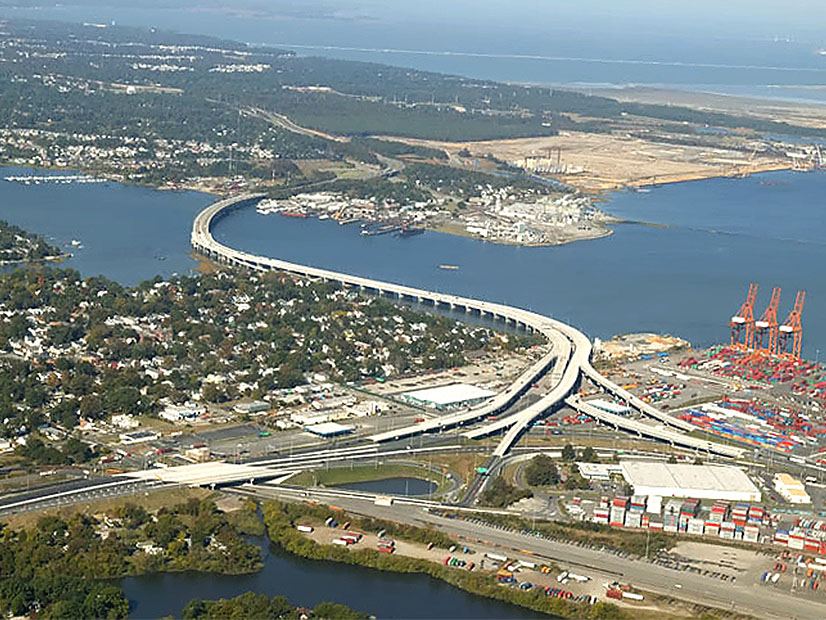
The buildout of a homegrown U.S. supply chain for offshore wind took a big step forward Monday with the announcement that Siemens Gamesa Renewable Energy (SGRE) will establish a new plant for offshore wind blades at the Portsmouth Marine Terminal in Virginia.
The facility, the first of its kind in the U.S., was announced by Gov. Ralph Northam at a press event on Monday at the terminal, which is located on the southern end of the Virginia coast. The plant will be a “finishing” facility, where blades manufactured elsewhere are painted and assembled prior to installation, according to Steve Dayney, head of offshore wind for Siemens Gamesa North America.
On completion, the plant will be capable of finishing blades for 100 turbines per year, and its initial output will go to Dominion Energy’s 2.6 GW Coastal Virginia Offshore Wind (CVOW) project, Dayney said in an email to NetZero Insider. Dominion selected Siemens Gamesa as turbine supplier for the project in January 2020.
Monday’s announcement also comes two months to the day after Dominion’s parallel commitment to lease 72 acres at the Portsmouth terminal to be used for staging and assembly on CVOW. (See Dominion Secures 10-Year Va. Port Lease for OSW Staging.)
Northam hailed the two companies’ work on the project as “the most important clean-energy partnership in the United States. This is good news for energy customers, the union workers who will bring this project to life and our business partners.”
SGRE will be investing around $200 million in the plant, which will create 310 permanent positions, according to a company press release. The project timeline and number of temporary jobs to be created during the construction phase of the facility have yet to be determined but will be keyed to progress on CVOW, Dayney said.
Both he and Energy Secretary Jennifer Granholm linked Monday’s announcement to the ongoing negotiations in Congress over the budget reconciliation package, which could still provide funding for major clean energy provisions in President Joe Biden’s Build Back Better agenda.
Supporting the president’s agenda, Granholm said, would show “that the United States is open for clean energy business. Virginia is helping lead the way to strengthen the nation’s domestic supply chains for renewable energy and keep energy prices affordable for American households as we strive for a cleaner future.”
“As Congress considers taking historic action on climate, this facility evidences that offshore wind can create significant new manufacturing activity and quality jobs [for] American communities,” Dayney said. “We are hopeful this commitment will lead to further action by federal and state policy makers to establish policies to provide long-term certainty and help sustain the competitiveness of this facility in the global marketplace for decades to come.”
30 GW by 2030
Certainty — from policy makers and investors — is critical to Europe’s offshore giants like Siemens Gamesa, which is based in Spain, and Ørsted, from Denmark, as they compete for projects in a U.S. market that could accelerate rapidly as it pursues Biden’s goal of deploying 30 GW of offshore wind by 2030.
Both companies are planning facilities on the Atlantic Coast, with Ørsted recently announcing an investment of close to $70 million in Crystal Steel, a company on Maryland’s Eastern Shore. The money will be used to expand Crystal’s plant — and hire 50 new employees — to provide steel for projects to be located off the Maryland and New Jersey coasts.
Similarly, Virginia, New Jersey and other East Coast states are in heated competition to become the supply chain and operations hub for offshore wind on the Atlantic coast.
Speaking before the House Energy and Commerce Committee on Oct. 21, David Hardy, CEO of Ørsted North America, said his company is following a two-pronged approach to building a U.S. supply chain, expanding the capacity of U.S. partners such as Crystal Steel, while also bringing other European companies into the market.
But echoing Dayney, Hardy said building out the U.S. supply chain will take time, regulatory certainty and incentives, noting that Europe’s mature offshore supply chain took decades to build. (See House E&C Hearing Pits Offshore Wind Against High Energy Prices.)
The turbine blades to be finished in SGRE’s Virginia facility could come from European plants where the company casts the massive blades that could be used for CVOW, pending finalization of the supply contract with Dominion.
Again, Dayney declined to provide details on the kind and size of the blades that will be used for CVOW. But, according to the company website, its offshore blades are made from fiberglass and epoxy resin, cast in one piece. The newest models being rolled out in the next few years will top out at more than 100 meters or close to 330 feet.
Whether Siemens Gamesa will expand the finishing facility to include blade manufacturing will depend on whether the company wins contracts for future projects in Virginia or other East Coast states, Dayney said. While recognizing the benefits of a U.S. supply chain, he said, “the establishment of a blade manufacturing facility, including casting, is a major investment, and SGRE has therefore decided to establish the facility through a phased approach.”


